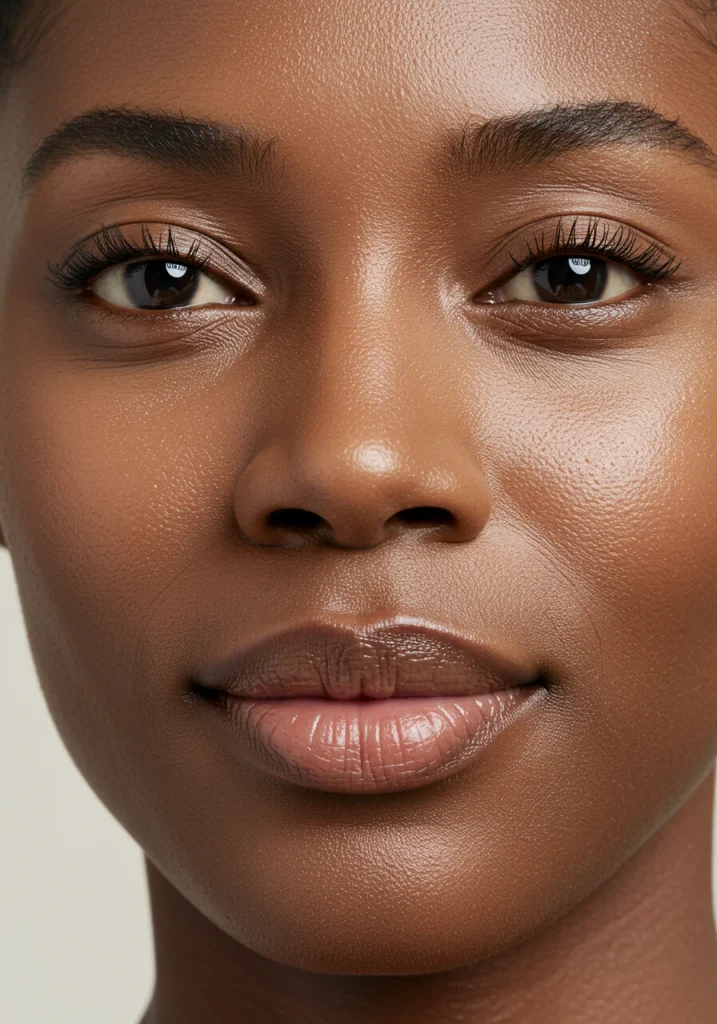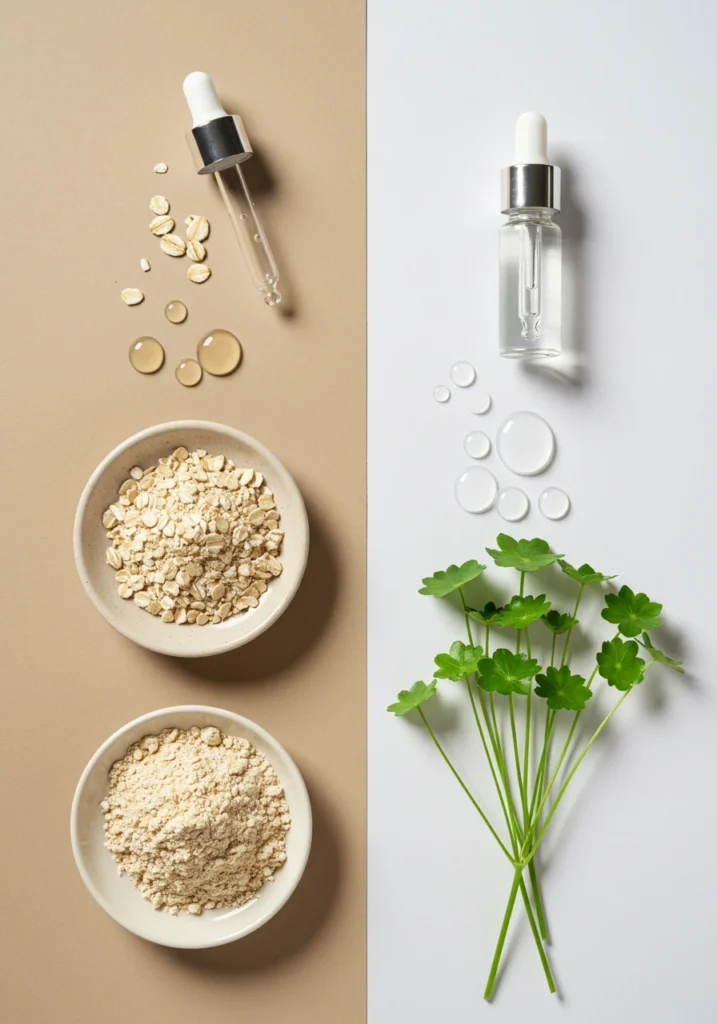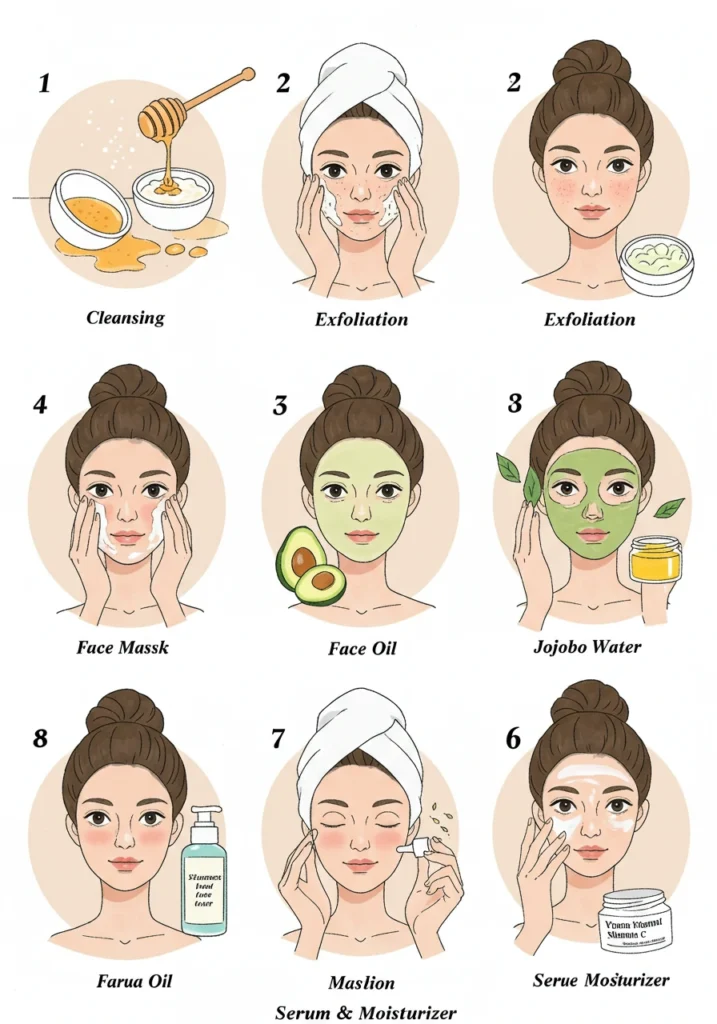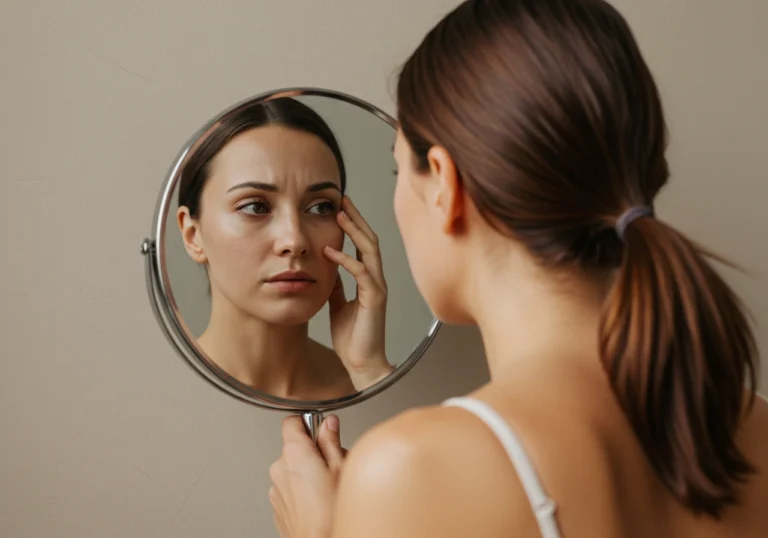Table of Contents
Tired of dealing with inflamed, reactive skin that seems to flare up with every new product you try? Having sensitive skin can feel like navigating a minefield, where even the most innocuous-seeming products can trigger redness, irritation, and discomfort. But achieving that coveted natural glow isn’t out of reach—even for the most sensitive skin types.
After years of working with clients with reactive skin concerns and testing countless gentle formulations, I’ve developed a foolproof 7-step routine that actually calms and nurtures sensitive skin rather than aggravating it. This approach focuses on strengthening your skin barrier, reducing inflammation, and introducing moisture without overwhelming your skin’s delicate balance.
In this comprehensive guide, you’ll discover the exact ingredients to embrace (and which to avoid), how to layer products properly, the perfect frequency for exfoliation, and specialized techniques that respect your skin‘s sensitivities while still delivering visible results. Plus, I’ll share expert tips on handling seasonal changes and hormonal fluctuations when your skin sensitivity might peak.
Why This Skincare Routine Works

Unlike generic skincare approaches that can overwhelm sensitive skin, this routine is specifically calibrated to work with your skin‘s natural processes, not against them:
- Formulated with gentle, skin-loving ingredients that support barrier repair
- Emphasizes hydration and strategic calming techniques for a natural glow
- Completely free from common irritants, harsh chemicals, and artificial additives
- Designed to build tolerance gradually while strengthening skin‘s resilience
- Focuses on prevention of inflammation rather than treating reactions after they occur
The beauty of this method lies in its simplicity and consistency. By removing the common triggers and introducing only what sensitive skin truly needs, you’ll notice fewer flare-ups within days and significant improvement in your skin’s overall appearance within weeks.
Choosing the Right Ingredients

Soothing Heroes for Sensitive Skin
When dealing with sensitive skin, ingredient selection becomes crucial. These gentle powerhouses deliver results without irritation:
- Centella Asiatica (Cica): A traditional healing herb that reduces redness and strengthens the skin barrier
- Niacinamide (Vitamin B3): In concentrations of 2-5%, it strengthens the skin barrier while reducing inflammation
- Ceramides: These lipids naturally occur in skin and help repair and maintain your skin’s protective barrier
- Hyaluronic Acid: A hydration hero that draws moisture into the skin without irritation
- Oat Extract/Colloidal Oatmeal: Contains anti-inflammatory avenanthramides that immediately calm irritated skin
What to Strictly Avoid
Sensitive skin types should steer clear of these common irritants:
- Alcohol denat. and other drying alcohols (look for “alcohol” early in ingredients lists)
- Synthetic fragrances and essential oils (even natural ones can trigger reactions)
- Chemical sunscreens (opt for mineral/physical options with zinc oxide or titanium dioxide)
- Harsh sulfates like Sodium Lauryl Sulfate (SLS)
- High-concentration acids and retinols without proper introduction
Gentle Alternatives
When you need substitutions for common but potentially irritating ingredients:
- Instead of retinol: Try bakuchiol, a plant-based alternative that provides similar benefits without the irritation
- Instead of vitamin C serums: Try less acidic forms like magnesium ascorbyl phosphate or sodium ascorbyl phosphate
- Instead of physical scrubs: Use enzyme-based exfoliants with papain or bromelain
- Instead of foaming cleansers: Choose cream, milk, or oil-based cleansers
The 7-Step Routine: Ingredients & Prep
Morning Routine Essentials
- Gentle Cleanser: Water or a pH-balanced cleanser (pH 4.5-5.5)
- Hydrating Toner: Alcohol-free formulation with glycerin and ceramides
- Soothing Serum: Centella asiatica or niacinamide-based
- Moisturizer: Fragrance-free cream with ceramides, glycerin, and squalane
- Mineral Sunscreen: SPF 30-50 with zinc oxide and/or titanium dioxide
Evening Routine Essentials
- Oil or Balm Cleanser: For makeup and sunscreen removal
- Gentle Cleanser: Same as morning
- Treatment Product: Barrier-supporting ingredients (alternate with extremely gentle exfoliation once weekly)
- Moisturizer: Same as morning or a slightly richer version
- Optional Occlusive: Thin layer of healing ointment on dry or irritated areas
Before You Begin
- Perform a patch test with any new product on your inner forearm for 24 hours before applying to your face
- Introduce only one new product every two weeks to clearly identify potential triggers
- Keep a skin journal to track reactions and identify patterns
Step-by-Step Application Instructions

Step 1: Cleansing Without Compromising
Morning: Many with sensitive skin benefit from simply rinsing with lukewarm water rather than using a cleanser, which preserves your skin’s natural protective oils. If you prefer using a cleanser, choose a gentle, non-foaming formula and massage it with fingertips using light, circular motions for 30-60 seconds.
Evening: Begin with an oil-based cleanser if wearing makeup or sunscreen. Place 1-2 pumps on dry hands and gently massage over dry face for 60 seconds, then rinse with lukewarm water. Follow with your gentle cleanser using the same light touch.
Essential technique: Pat—don’t rub—your face dry with a clean, soft microfiber cloth. Leave skin slightly damp for the next step.
Step 2: Hydrating & Balancing Toner
Apply 3-4 drops of an alcohol-free toner to clean palms, then press gently into still-damp skin. This step helps restore your skin’s pH balance while providing the first layer of hydration.
Key point: Avoid toners in cotton pads, which can cause unnecessary friction on sensitive skin.
Step 3: Targeted Treatment Serum
Apply a pea-sized amount of your chosen serum, focusing on specific concerns:
- For redness: Centella asiatica or green tea extract
- For dehydration: Hyaluronic acid with ceramides
- For overall sensitivity: Niacinamide at 2-5% concentration
Allow the serum to fully absorb for 1-2 minutes before proceeding.
Step 4: Strategic Moisturizing
Take a small amount of moisturizer and warm it between fingertips before gently pressing (not rubbing) into skin. Pay extra attention to areas that tend to become dry or irritated.
Morning: Choose a lighter formula that works well under sunscreen. Evening: Opt for a slightly richer texture to support overnight repair.
Step 5: Sun Protection (Morning Only)
Apply a quarter-sized amount of mineral sunscreen as the final step of your morning routine. Use gentle patting motions rather than rubbing to minimize irritation.
Critical note: Reapply every 2 hours when exposed to direct sunlight, even on cloudy days.
Step 6: Extremely Gentle Exfoliation (Once Weekly)
Use only enzyme-based exfoliants or PHA (polyhydroxy acid) products specifically formulated for sensitive skin. Apply a thin layer according to product instructions, typically for 5-10 minutes, then rinse thoroughly with lukewarm water.
Safety first: Skip this step entirely during active flare-ups or periods of increased sensitivity.
Step 7: Overnight Recovery
In the evening, consider applying a thin layer of a ceramide-rich recovery cream or healing ointment to specific areas of dryness or irritation. This creates a protective seal that maximizes your skin’s natural overnight repair processes.
Pro Tips for Radiant Results
Avoiding Irritation Triggers
- Temperature sensitivity: Never use hot water on sensitive skin—lukewarm is ideal
- Environmental protection: Consider how weather affects your skin and adjust accordingly
- Internal factors: Track how diet, stress and hormonal changes affect your skin’s sensitivity
- Cross-reactivity: Be cautious with skincare containing plant ingredients if you have pollen allergies
Recommended Tools & Techniques
- Facial massage: Use gentle, upward strokes with ring fingers for product application
- Cooling tools: Keep jade rollers or gua sha tools in the refrigerator to help calm inflammation
- Silk pillowcases: Reduce friction against your skin while sleeping
- Humidifier: Maintain optimal environmental moisture, especially during winter months
Tracking Progress
Take weekly photos in the same lighting to track your skin’s improvement objectively. Many sensitive skin improvements happen gradually and can be difficult to notice day-to-day.
Custom Variations for Different Sensitive Skin Types
For Sensitive + Dry Skin
- Add 2-3 drops of squalane oil to your nighttime moisturizer
- Use cream-based products rather than gels or lotions
- Consider overnight hydrating masks twice weekly
- Focus on lipid-replenishing ingredients like ceramides and fatty acids
For Sensitive + Oily/Combination Skin
- Use lightweight, oil-free gel moisturizers
- Consider niacinamide as your primary treatment ingredient
- Use clay masks only on T-zone, and for reduced duration (5-7 minutes maximum)
- Hydrate with multiple layers of lightweight hydrating toners rather than heavy creams
For Sensitivity with Rosacea Tendencies
- Incorporate azelaic acid (start with 10% concentration)
- Avoid all physical exfoliation
- Be extra vigilant about sun protection
- Consider green-tinted primers to neutralize redness
- Keep skincare products in the refrigerator for a cooling effect
Best Times to Adapt Your Routine
Seasonal Adjustments
- Summer: Focus on lighter layers and increased sun protection
- Winter: Incorporate more emollient products and consider using a humidifier
- Spring/Fall transitions: These are often peak sensitivity periods—simplify your routine during these weeks
Hormonal Fluctuations
- During periods of hormonal change, reduce active ingredients and focus on barrier support
- Track your cycle if applicable—sensitive skin often flares at predictable intervals
Travel Considerations
- Pack minimal, proven products rather than experimenting while away from home
- Hydrate more intensively during and after air travel
- Consider how different water qualities might affect your skin when traveling
FAQs
Q: How long before I see results with this sensitive skin routine? A: Most people notice reduced irritation within 3-5 days, with significant improvement in skin texture and tone after 4-6 weeks of consistent use. Remember that barrier repair takes time, so patience is essential.
Q: Can I still use anti-aging products with sensitive skin? A: Yes, but choose gentle alternatives like peptides, barrier-supporting ceramides, and bakuchiol instead of traditional retinols or high-concentration acids. Introduce them slowly, starting with twice-weekly application.
Q: Is double cleansing safe for sensitive skin? A: When done properly with appropriate products, double cleansing can actually be beneficial. The key is using a gentle oil-based first cleanser followed by a non-stripping cream or gel cleanser, and never overworking the skin.
Q: What should I do during an active flare-up? A: Immediately simplify your routine to just cleansing, moisturizing, and sun protection. Avoid all active ingredients until skin calms down. Consider applying a thin layer of pure aloe vera gel or a 1% hydrocortisone cream (for short-term use only) on affected areas.
Q: How do I introduce new products safely? A: Always patch test for 24 hours, then apply the product to just one small area of your face for three days before using it all over. Introduce only one new product every two weeks so you can clearly identify any triggers.
Conclusion
Creating an effective skincare routine for sensitive skin isn’t about finding miracle products—it’s about understanding your skin’s unique needs and responding with thoughtful care. This 7-step approach focuses on strengthening your skin’s natural defenses while providing the gentle nourishment it craves.
Remember that consistency is key, and patience with your sensitive skin will yield the best results. By following this carefully calibrated routine, you’ll not only manage reactivity but also build resilience over time, revealing that natural glow that comes from truly healthy skin.
Your skin’s sensitivity isn’t a limitation—it’s simply asking for more intentional care. By honoring its needs rather than fighting against them, you’ll develop not just a skincare routine, but a relationship with your skin that fosters lasting health and radiance.







